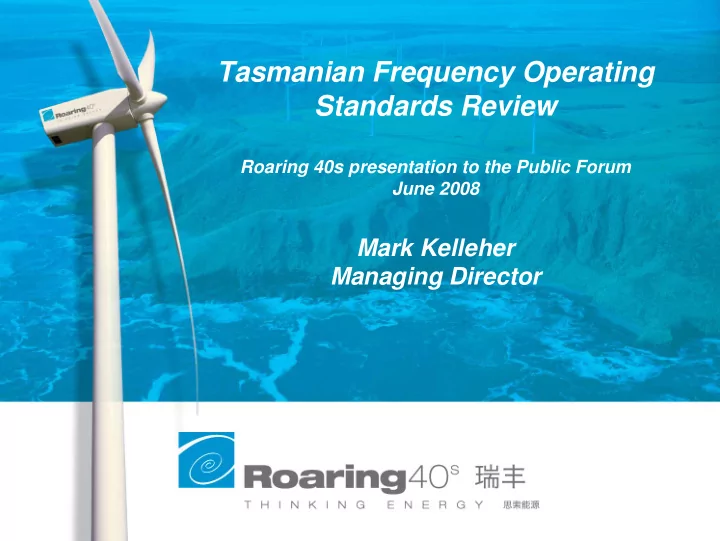

Tasmanian Frequency Operating Standards Review Roaring 40s presentation to the Public Forum June 2008 Mark Kelleher Managing Director
Roaring 40s Background • Roaring 40s was formed October 2005 as a Joint Venture (50/50) between Hydro Tasmania and China Light and Power (CLP Group) • New business vehicle enabling global investment and partnerships in renewable energy projects • Roaring 40s business model is to develop, construct and operate renewable energy projects over the entire project life cycle Vision To be the leading wind energy developer in Australia and the leading international wind energy developer in China and India
China and India • Jilin Shuangliao 49.3 MW – Operating • Shandong Rongcheng 48.75 MW – Operating • Khandke 50 MW – Under Construction • Jilin Datong 49.5 MW – Under Construction • Shandong Hekou 48.75 MW – Under Construction • Shandong Lijin 48.75 MW – Under Construction • Shandong Zhanhua 48.75 – Under Construction • Jilin Shuangliao Phase II 50 MW – Commencing Construction • Hekou Phase II 50 MW – Under Development • Lijin Phase II 50 MW – Under Development • Zhanhua Phase II 50 MW – Under Development
Australia • Woolnorth Bluff Point 65 MW – Operational • Woolnorth Studland Bay 75 MW – Operational • Cathedral Rocks 66 MW – Operational • Musselroe 129 MW - Advanced • Waterloo 120 MW – Advanced • Sidonia Hills 70 MW – Under Development • Stony Gap 129 MW – Under Development • Robertstown 96 MW – Under Development
The Australian Outlook • With the Federal Government’s policy of extending MRET and introducing carbon trading, demand for wind generation will increase • It is estimated that over 12 GW of wind generation will be installed in Australian over the next 10-12 years • This will require full utilisation of the higher quality wind resources of South Australian, Victoria and Tasmania • Tasmanian wind resources have a key role to play in meeting Australia’s renewable energy target of 20% at 2020
Roaring 40s Tasmanian Outlook • Roaring 40s currently has 140 MW of installed capacity in Tasmania, with a further 250 MW under development or consideration • Technical barriers to high levels of wind penetration are being progressively over come, including: • Fault ride through and fault level contribution are now standard features on large wind turbines; and • Fast voltage control and fast governor response is now available • Increasingly, higher levels of instantaneous wind penetration are being witnessed across the globe, including highly integrated systems, such as in Denmark, through to small isolated systems such as King Island
Importance of Frequency Standards • High levels of wind generation reduce the mechanical inertia of the power system • Broad frequency standards allow low inertia systems time to recover from disturbances • Tight frequency standards make it difficult to manage frequency under high levels of wind penetration and will at some point require limiting the output of wind generation • Tasmanian wind developers would have to account for lost production resulting from tighter frequency standards • This will eventually result in mainland Australian sites being developed in preference to Tasmanian sites despite the superior wind resources and lower development costs
Gas Generation Costs and Benefits • Roaring 40s understands that the review has been triggered due to two specific proposed projects • While not aware of the full details, it is Roaring 40s understanding that current gas plant in Tasmania operates within existing Frequency Standards (FS) • Narrowing the FS for a specific technology configuration results in a cost being passed on to the entire sector • Roaring 40s questions whether the technology proposed is the appropriate approach or whether augmentation is possible to allow for greater integration with the existing system
NEM Wind development • Quantification of the ability of the Tasmanian system to accept energy from wind generation for different frequency standard outcomes is required- can Transend and NEMMCO assist with their models? • The economic impact on the NEM from shifting wind generation development from Tasmania’s high quality resources to lower grade resources in QLD and NSW needs to be understood. What information does the Panel need to make this assessment?
Innovative Solutions? • Focus to date appears to be on changing the Frequency Operating Standards to facilitate entry of a specific technology configuration into the Tasmanian system • The decision is not straight forward as tightening the frequency standards will result in costs and detriment to the broader industry • Roaring 40s acknowledge the constraints of the terms of reference issued to the Reliability Panel for this review • Roaring 40s strongly encourage both the Reliability Panel and the industry participants in the room today to investigate all potential options for facilitating development of Tasmanian’s generation sector while minimising impacts on the broader industry
Recommend
More recommend